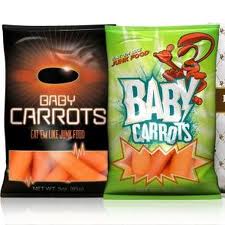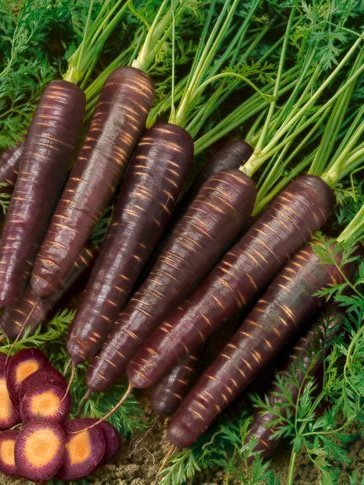A carrot a day

I love carrots. I eat one just about every day. They're so versatile. What other vegetable can you eat raw and cooked, savoury and sweet, in salad or as juice as well as in a cake? Got the afternoon munchies? Grab a raw carrot to tide you over. Looking for a pre-dinner nibble? Carrot sticks make a great low-kilojoule/calorie substitute for crackers with a dip.
At dinner, they liven up stir-fries and are one of the most universally liked vegetables - no-one says no to carrots. I finish my boiled carrots off with a splash of olive oil and chopped parsley or just a little honey to bring out their sweetness - yum.
Carrots keep well in the fridge unlike leafy things like lettuce or fresh herbs. Peel them on the weekend and store a bunch in a container in the fridge ready to chomp on during the week. Unlike tomatoes, there's no mess when you slice them. Best of all, kids love them - mine used to pinch slices of raw carrot when I was preparing the vegetables for dinner.
Nutrition highlights
Nutritionally they punch above their weight. No fat, stacks of fibre and the highest content of beta-carotene of any vegetable. Beta-carotene is an orange-yellow pigment that is converted to vitamin A in the body and is required for eyesight. It - and related carotenoids like alpha-carotene and lutein - have antioxidant activity which research suggests may help prevent cancer and protect against eye problems in later life.
The bright orange colour of carrots is the key - the stronger and more intense the colour, the higher the content of carotenoids.
Just one medium carrot has around 12 milligrams of beta-carotene - more than twice the suggested intake of 5 to 6 mg a day (there is no recommended dietary intake for this pro-vitamin).
Cooking doesn't diminish this level - it's all there, whether raw or boiled.
"If you don't want the dietitian to give you stick,
eat the carrot she's dangling!"
Help you see in the dark?
Deficiency of vitamin A results in night blindness which is an inability to see in dim light. If prolonged and severe, it can eventually lead to total blindness. Carrots were issued to British night-flying pilots during World War II in the hope of improving their night vision, and this has perpetuated the belief that carrots help you see in the dark. They certainly can help your vitamin A status but whether eating lots really does help you see significantly better is debatable. Nonetheless it's a handy line for parents to remember to entice their kids to eat their vegetables!
Overdose of beta-carotene
As with everything, you can have too much of a good thing. Large quantities of carrots - most commonly from carrot juice which concentrates what's in carrots - can lead to yellow colouration of the skin (but not the whites of the eyes as with jaundice). The carotene pigments are fat-soluble and are stored in fat deposits around the body, including the skin, producing a yellow-orange tinge.
Although unsightly, it is not harmful and once you stop eating the carrots, your skin will return to normal. You'll look ‘golden bronzed' in the meantime!

A happy family
Carrots belong to the same botanic family as parsnip, fennel and celery. Being a root vegetable, you'd think they would have a lot of starch but no! There's surprisingly no starch but a higher-than-normal content of sugars which accounts for their sweetish taste. They supply good amounts of the mineral potassium but little vitamin C.
Carrots good for weight control
Carrots are an easy, fat-free snack and they're low GI (41) so they'll fill you up and stick with you for longer. They're on a par with chick peas at 40. They help you feel full without overdoing it in a most convenient way. As one researcher wrote: "If your plate is piled high with carrots, there's less room for chips or stodge".
Forget apples. It's a carrot a day that keeps the doctor
- and the dietitian - away.
Nutrition stats
One medium carrot (weighing 100g raw) supplies:
1g protein, trace of fat, 5g sugars, no starch, 4g fibre and 105 kilojoules (26 calories)
Carrots in the news
Baby carrots- eat 'em like junk food  A new $25 million campaign has been launched in the US to promote packs of small new carrots as a healthy alternative to chips and other salty packet snack foods.You'll see billboards with the message "The original orange doodles" and packing baby carrots in chipls-style small bags and selling them in vending machines. There's also a phone app powered by the sound of people munching on carrots. I think this is a great way to market vegetables to kids - produce growers can use the same techniques of junk food selling to make carrots convenient, fun and attractive to eat. After all, years of cajoling, nagging and bribing by parents haven't worked! Read more.
A new $25 million campaign has been launched in the US to promote packs of small new carrots as a healthy alternative to chips and other salty packet snack foods.You'll see billboards with the message "The original orange doodles" and packing baby carrots in chipls-style small bags and selling them in vending machines. There's also a phone app powered by the sound of people munching on carrots. I think this is a great way to market vegetables to kids - produce growers can use the same techniques of junk food selling to make carrots convenient, fun and attractive to eat. After all, years of cajoling, nagging and bribing by parents haven't worked! Read more.
Purple carrots hailed as a new 'super food'
 Carrots were originally purple in colour and hail from ancient Persia. Like heirloom tomatoes, purple carrots have all but disappeared from supermarket produce (carrots can also come in yellow, white and reddish tinges too, all different varieties with different antioxidants and vitamins). An Australian study tested purple carrot juice on rats and reported improvements in blood pressure, blood glucose, liver and heart function. The purple carrots have 28 times more anthocyanins - the purple-red pigment of blueberries - than the orange ones. Read more.
Carrots were originally purple in colour and hail from ancient Persia. Like heirloom tomatoes, purple carrots have all but disappeared from supermarket produce (carrots can also come in yellow, white and reddish tinges too, all different varieties with different antioxidants and vitamins). An Australian study tested purple carrot juice on rats and reported improvements in blood pressure, blood glucose, liver and heart function. The purple carrots have 28 times more anthocyanins - the purple-red pigment of blueberries - than the orange ones. Read more.



